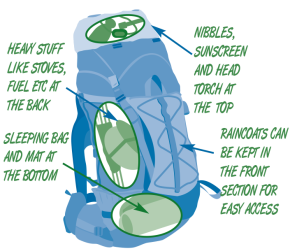
- Solid walking boots
Good grip, worn-in & comfortable. Sneakers have little grip and can be slippery - ¾ length waterproof rain jacket with hood
Showerproof spray jackets & quilted parkas are not waterproof & create a real danger of hypothermia (lowering of core body temperature to dangerous levels) - Warm jumper of wool or polyester fleece
Cotton shirts (while great in summer) & windcheaters have minimal insulation when wet & retain water. Wool and polyester provide greater protection from heat loss in cool conditions - Shorts or loose, comfortable wool/synthetic pants
Jeans are not suitable as they are cold & heavy when wet - Wide brimmed sunhat & sunscreen
Think about your ears, face and neck Sunglasses with strap
Be sun smart! - Woollen beanie & gloves
If you have to stop in the bush, you WILL get cold - Wrist watch
Someone needs to keep track of the time! - Map & Compass
Carried by someone who knows how to use them - Mobile Phone/communication system
Will your mobile phone work? Telstra phones have the best range in the bush, but not everywhere. You may consider other communication systems for more remote areas - Water, minimum 2 litres
This is per person, per day. Also consider how much extra you’ll need for meals - Food
For short walks; nutritious snacks & a piece of fruit. All day walks; take the same plus lunch & perhaps a thermos or fuel stove for a hot drink - Medical information & contact details
Details need to include person’s name, address, date of birth and contact details, rele vant medical history and records of medications currently taken/ medical management plans to follow, and an emergency contact while on the walk - Personal medications
Clearly identified. Tell your leader where you keep it, why & when you use it - First aid / Emergency kit
Per person: sunscreen, bandaids, space blanket, cigarette lighter, 2x roller bandage, 1x triangular bandage, blister protection, and 5 metres Venetian blind cord (or similar) - Group first aid kit
Go for an outdoor/adventure kit, and get some accredited training on how to use it - A whistle on a neck cord
3 blasts for the lost, 1 for rescuer - Small torch
Take spare batteries, always! - A quality day pack
Comfortable harness & padded hip strap - Shelter from the elements
Your group may need to get out of the weather. Carrying a tarp, hootchie or emergency blanket - Optional extras
Thermal top & bottom, waterproof over-trousers.
Gaiters (depending on terrain, but useful in grassy or prickly conditions to protect your lower legs), camera (with spare batteries), thermos, sit-on foam mat

